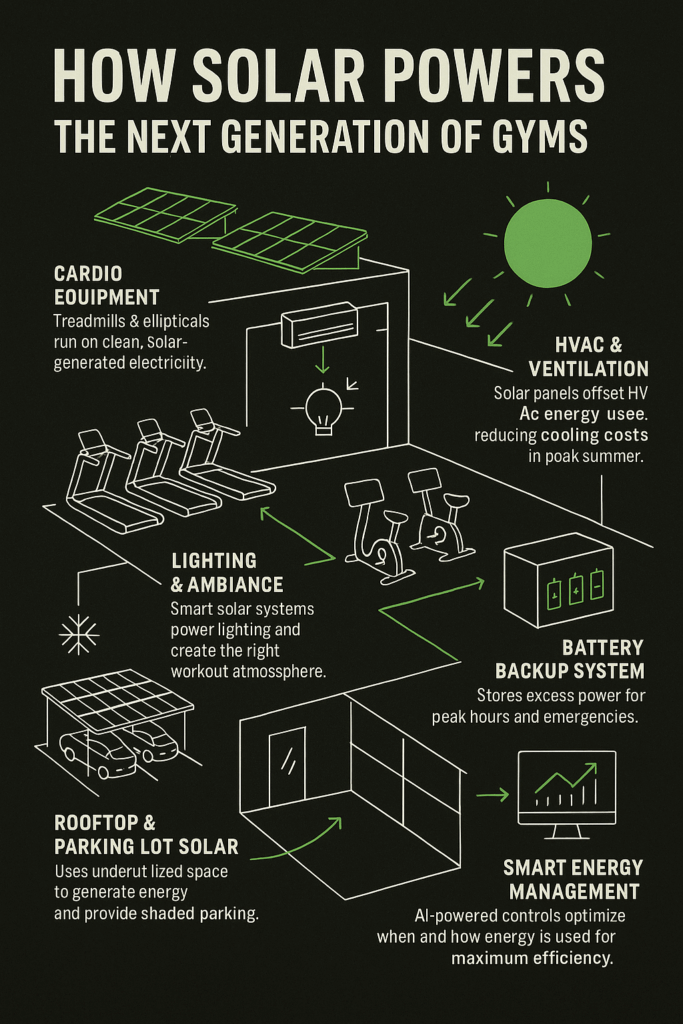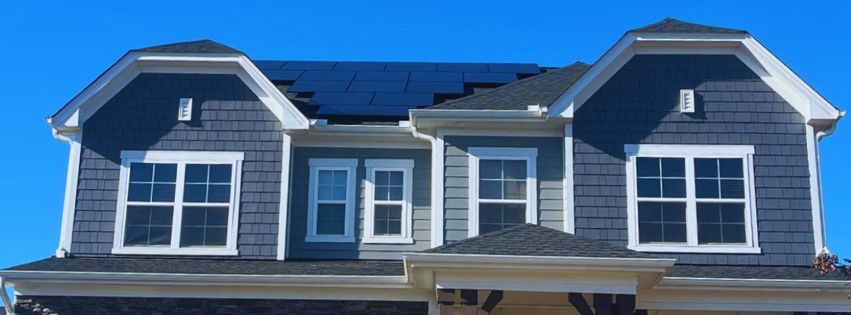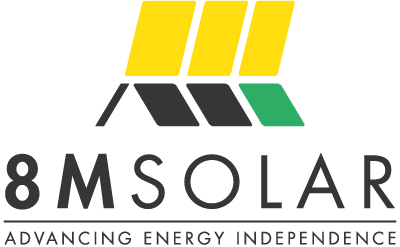Imagine walking into your local gym, and while members are burning calories on treadmills and lifting weights, the facility is powered by clean energy from the sun. A standard gym facility uses between 30,000-50,000 kWh of electricity per year—equivalent to the electricity consumption of approximately 10-15 households. For many fitness centers, energy costs can reach nearly $70,000 annually, making solar power an attractive solution for gym owners looking to cut costs while building a sustainable future.
The fitness industry is experiencing a green revolution, and solar-powered gyms are leading the charge. Gym owners face mounting pressure from rising electricity costs, environmentally conscious members, and the need to differentiate themselves in a competitive market. Traditional gyms consume massive amounts of energy to power everything from cardio equipment and lighting to HVAC systems that keep members comfortable during intense workouts. This creates the perfect storm of high operational costs and environmental concerns that smart business owners are addressing head-on.
Solar energy offers gym owners a powerful solution that tackles both challenges at once. By installing solar panels, fitness centers can reduce their electricity bills exponentially. Solar-powered gyms have experienced a 30% increase in membership due to their sustainable practices, proving that going green isn’t just good for the planet—it’s good for business.
In this guide, we’ll explore how solar energy is transforming the fitness industry, from the technology that makes it possible to the real-world success stories of gyms that have made the switch. You’ll discover the financial benefits, environmental impact, and practical considerations of solar-powered fitness facilities, plus learn how 8MSolar can help your gym join the sustainable fitness movement.
What Are Solar-Powered Gyms?
Solar-powered gyms are the next evolution in fitness facility design and operation. At their core, these are fitness centers that harness the sun’s energy through photovoltaic panels to generate clean electricity that powers their daily operations. Rather than relying on traditional grid electricity, these facilities produce their own renewable energy on-site, reducing their dependence on conventional power sources.
The integration of solar technology into gym operations is surprisingly seamless. Solar panels installed on rooftops, parking structures, or ground-mounted arrays capture sunlight and convert it into electricity through the photovoltaic effect. This clean energy flows directly into the gym’s electrical system, powering everything from cardio equipment and lighting to HVAC systems and sound systems. When the solar system produces more electricity than the gym consumes, the excess energy can be stored in battery systems for later use or fed back into the grid through net metering programs.
What makes gyms well-suited for solar energy is their energy consumption pattern. Most fitness centers experience peak energy usage during daylight hours when members are most active—exactly when solar panels produce the most electricity. This natural alignment between energy production and consumption maximizes the value of every kilowatt-hour generated, creating an ideal symbiotic relationship between solar technology and fitness operations.
The numbers tell a story about the potential for solar savings in the fitness industry. A standard gym facility uses between 30,000-50,000 kWh of electricity per year, while larger fitness centers may consume up to 75,000 kWh annually. Solar installations can slash gym energy costs by up to 70%, transforming one of the largest operational expenses into a manageable cost. An estimated 33% of fitness facilities across the United States have already implemented solar panel systems, recognizing the financial benefits of sustainable operations.
For gym owners considering this transition, the financial case is compelling. A 50 kW solar system generates roughly 60,000 kWh each year, offsetting about 40 metric tons of carbon emissions while providing decades of reduced energy costs. With federal tax credits, state incentives, and rapidly declining solar equipment costs, the investment in solar technology has never been more attractive for fitness facilities looking to secure their energy future while demonstrating environmental leadership to their communities.
Why Gyms Need Solar Now More Than Ever
Walk into any gym owner’s office, and you’ll likely find them staring at an electricity bill that looks more like a mortgage payment. The fitness industry faces a unique energy challenge that’s only getting worse. Between the rows of power-hungry treadmills running 12+ hours daily, the massive HVAC systems needed to keep sweaty members comfortable, and the bright lighting required for safety and atmosphere, gyms are energy consumption powerhouses.
A standard gym facility uses between 30,000-50,000 kWh of electricity per year, while larger fitness centers can consume up to 75,000 kWh annually. At current electricity rates averaging $0.15 per kWh, that translates to $4,500-$11,250 in annual energy costs for a typical gym—and that’s before factoring in peak demand charges that can push costs even higher during busy evening hours.
But here’s what’s really alarming: energy prices have been rising faster than gym membership fees can keep pace. Many gym owners are discovering that their second-largest expense after rent is now their electric bill. This creates a vicious cycle where operators either absorb the rising costs (crushing profit margins) or pass them onto members (risking membership loss in a competitive market).
Members Want Green—And They’re Willing to Pay for It
Today’s fitness enthusiasts aren’t just conscious about their physical health; they’re also concerned about the health of the planet. 80% of gym-goers consider environmental friendliness an essential factor when choosing a fitness facility.
The numbers tell the story: solar-powered gyms have experienced a 30% increase in membership due to their sustainable practices. These aren’t just feel-good statistics, they show real revenue growth. When members see solar panels on your roof, they’re seeing a gym that aligns with their values and demonstrates long-term thinking.

How Solar Technology Transforms Gym Operations
Solar technology offers gyms multiple pathways to energy independence, each designed to maximize energy production and aesthetic appeal:
Rooftop Installations: The most popular choice for urban gyms, rooftop solar systems make perfect use of typically underutilized space. Modern mounting systems accommodate virtually any roof type, from flat commercial roofs to sloped structures. For gyms, rooftop installations offer the added benefit of providing natural cooling by shading the building, reducing HVAC loads during peak summer months.
Ground-Mounted Arrays: Gyms with available land can optimize their solar production with ground-mounted systems that can be angled for maximum sun exposure. These installations offer easier maintenance access and can be expanded more easily as energy needs grow.
Solar Parking Canopies: Solar canopies serve double duty by generating clean energy while providing covered parking for members. These structures enhance the member experience while maximizing property utilization—a win-win that many gym owners overlook.
The Technology Behind the Savings
Modern gym solar installations go beyond simple panels on the roof. Today’s systems include energy management technology that learns your facility’s usage patterns and optimizes energy flow. Smart inverters can adjust power output based on real-time demand, while monitoring systems provide insights into energy production and consumption patterns.
Battery storage systems allow gyms to store excess energy generated during peak sun hours for use during evening rush periods, when both energy demand and utility rates are highest. This technology allows gyms to become their own power companies, buying low (or generating for free) and using high.
Gyms Leading the Solar Revolution
Total Fitness Lincoln
Total Fitness Lincoln installed a 285.77 kWp solar PV system featuring 697 solar panels mounted on their west-facing roof. The system generates 252,726 kWh annually, providing nearly 30% self-sufficiency while avoiding 118,733kg of CO2 emissions per year.
What makes this installation impressive is the strategic planning that went into maximizing efficiency despite challenges. The system was carefully positioned around existing roof features including skylights and HVAC equipment, achieving a performance ratio of 85.71% even with a modest 1.2% yield reduction from shading.
BPL Fitness Flex Mansfield
BPL Fitness Flex Mansfield’s 122kWp solar PV system delivered over £11,000 in annual energy savings while preventing 24 tonnes of CO2 emissions per year. This case study demonstrates that even mid-sized gyms can achieve substantial returns on solar investment when systems are properly sized and installed.
The Marketing Multiplier Effect
Beyond the energy savings, these solar-powered gyms discovered an unexpected benefit: marketing leverage. Solar installations serve as powerful visual statements about environmental commitment, generating positive media coverage and word-of-mouth marketing that traditional advertising can’t buy. Many solar gym owners report that their panels become conversation starters that help convert prospects into members.

The Numbers That Matter to Gym Owners
Commercial solar installations for gyms cost $1.83 per watt before incentives. For a 100 kW system suitable for a mid-sized gym, this translates to about $183,000 before any rebates or tax credits. However, this initial cost tells only part of the story.
System Size Recommendations by Gym Type:
- Small boutique studios (2,000-3,000 sq ft): 15-25 kW systems
- Mid-size fitness centers (5,000-8,000 sq ft): 50-100 kW systems
- Large commercial gyms (10,000+ sq ft): 150-300 kW systems
Federal and State Incentives
The financial landscape for commercial solar has never been more favorable, though recent policy changes require immediate attention:
Commercial Solar Investment Tax Credit (ITC): Businesses can claim 30% of their solar installation costs as a federal tax credit. Unlike residential solar tax credits (which were recently eliminated), the commercial solar ITC remains available at 30% through 2028 for projects that begin construction by July 4, 2026.
Bonus Incentives for Qualifying Projects: Commercial solar installations may qualify for additional bonus credits:
- 10% Domestic Content Bonus for using US-made steel and iron
- 10% Energy Community Bonus for projects in certified energy communities
- 10-20% Low-Income Bonus for projects serving qualified communities
Accelerated Depreciation: Commercial solar systems qualify for Modified Accelerated Cost Recovery System (MACRS) depreciation, allowing businesses to depreciate their solar investment over five years instead of the typical 20-year schedule.
Financing Options That Work for Gym Cash Flow
Smart gym owners don’t need to pay the full cost upfront. Multiple financing options make solar accessible:
Solar Loans: Traditional financing with typical terms of 10-20 years at competitive interest rates. Many gym owners prefer this option because they own the system and claim all incentives.
Power Purchase Agreements (PPAs): For larger multi-site gym groups, PPAs allow free solar installation and maintenance for 20-40 years, with reduced electricity costs from pre-agreed rates.
Solar Leasing: Lower upfront costs with predictable monthly payments, though the leasing company typically claims the tax benefits.
When Solar Pays for Itself
Solar installations can reduce gym energy costs by up to 70%, creating substantial cash flow improvements that often pay for the system within 5-8 years. Here’s a real-world example:
100 kW System for Mid-Size Gym:
- System cost: $183,000 before incentives
- After 30% ITC: $128,100
- Annual energy savings: $18,000-$25,000
- Payback period: 5.1-7.1 years
- 25-year savings: $450,000-$625,000
These numbers assume current electricity rates, but they become even more compelling when factoring in typical 2-3% annual utility rate increases. Solar locks in your energy costs for 25+ years, providing predictable operating expenses that every gym owner appreciates.
Next-Generation Solar Technology
The solar revolution in fitness is just beginning. As we look toward 2026 and beyond, breakthrough technologies are poised to transform not just how gyms generate power and how they operate as businesses.
Revolutionary Solar Technologies Hitting the Market
Perovskite-Silicon Tandem Cells
The most exciting development in solar technology is the emergence of perovskite-silicon tandem solar cells, which are breaking efficiency records at an unprecedented pace. These revolutionary panels combine traditional silicon with cutting-edge perovskite materials that share a unique crystal structure, allowing them to capture different wavelengths of light.
In just over a decade, perovskite solar cells have jumped from 3.8% efficiency to over 26%, making them one of the fastest-advancing solar technologies ever. When combined with silicon in tandem configurations, these cells have already exceeded 33% efficiency in laboratory settings—much higher than today’s commercial panels that operate at 15-20% efficiency.
First commercial perovskite tandem panels are expected to arrive in late 2025, with broader availability in 2026-2027. Oxford PV has already reached 28.6% efficiency for commercial-size panels, and companies like First Solar are investing $370 million in perovskite development facilities. For gym owners, this translates to 40-60% more power generation from the same roof space, dramatically improving ROI calculations.
Transparent Solar Panels
Imagine gym windows that generate electricity while maintaining visibility and natural light transmission. Transparent solar panels using advanced materials like transparent luminescent solar concentrators (TLSCs) are moving from research labs to real-world applications. These panels allow surfaces like windows, facades, and skylights to double as energy-harvesting devices without sacrificing visibility.
Bifacial and Flexible Solar
The latest bifacial solar panels capture sunlight from both sides, utilizing reflected light from gym rooftops, parking lots, and surrounding surfaces to increase electricity yield by up to 30%. Meanwhile, ultra-thin flexible perovskite panels can be integrated into curved surfaces, vehicle charging canopies, and even building materials themselves.
AI-Powered Energy Management
Beyond improved panels, the integration of artificial intelligence is transforming how gyms manage energy consumption and production. Smart energy management systems learn usage patterns, predict demand, and optimize energy flow in real-time.
Dynamic Load Management: AI systems can shift energy-intensive operations (like HVAC pre-cooling) to peak solar production hours, maximizing self-consumption and minimizing grid dependence.
Predictive Maintenance: Advanced monitoring systems use machine learning to predict equipment failures before they occur, ensuring optimal system performance and preventing costly downtime.
Member Engagement Platforms: Some gyms are implementing systems where members can track how their workouts contribute to the facility’s renewable energy goals, turning sustainability into a gamified member experience.
The Sustainable Fitness Movement Beyond Solar
Solar adoption is just one part of a broader sustainability revolution sweeping the fitness industry. This movement is being driven by environmental consciousness and business necessity, as 70% of gym-goers now prioritize eco-friendly facilities when choosing where to exercise.
Energy-Generating Equipment: Companies like SportsArt and Technogym are producing grid-tied exercise equipment that converts human kinetic energy into electricity. An hour of training on an eco-friendly stationary bike can generate up to 220 watts—enough to charge multiple smartphones or power LED lighting.
Carbon-Neutral Gym Operations: Leading fitness chains like The Gym Group in the UK have committed to net-zero carbon strategies, purchasing 100% renewable energy, eliminating gas-powered heating, and removing single-use plastics. These initiatives are environmental statements and proven member retention strategies.
Circular Economy Practices: The industry is embracing circular economy principles through equipment refurbishment programs, sustainable material choices (recycled rubber flooring, bamboo fixtures), and recycling initiatives.

Power Your Business with Clean Energy
The evidence is overwhelming: solar-powered gyms aren’t just reducing their environmental impact—they’re revolutionizing their business models. From slashing energy costs by up to 70% to attracting the 80% of gym-goers who prioritize environmental responsibility, solar energy delivers immediate financial benefits and long-term competitive advantages that position forward-thinking gym owners as industry leaders.
The Solar Success Formula for Fitness Facilities
Solar energy transforms your gym’s largest operational expense into a predictable, controllable cost while creating powerful marketing advantages that money can’t buy. Consider the Total Fitness Lincoln success story: their 285.77 kWp system generates nearly 30% self-sufficiency while avoiding 118,733kg of CO2 emissions annually. But beyond the impressive environmental impact, their solar installation serves as a daily reminder to members that this is a gym committed to innovation and sustainability.
The financial case is equally compelling. With commercial solar systems paying for themselves in 5-8 years and providing 25+ years of reduced energy costs, solar represents one of the few business investments that literally pays you back while improving your competitive position. As energy prices continue rising 2-3% annually, solar essentially locks in your electricity costs for decades, providing the kind of operational stability every business owner dreams about.
Your Partner in the Clean Energy Transformation
At 8MSolar, we’ve dedicated ourselves to making clean energy accessible and profitable for businesses across North Carolina. Whether you’re operating a boutique fitness studio, managing a multi-location gym chain, or running any type of commercial facility, we bring the expertise, technology, and commitment needed to transform your energy costs into competitive advantages.
Our approach goes beyond installing solar panels. We design energy solutions that maximize your savings, minimize your environmental impact, and position your business for long-term success. From initial consultation through system design, installation, and ongoing support, we handle every aspect of your solar journey with the same dedication to excellence that you bring to your members’ fitness goals.
The fitness industry stands at a pivotal moment. As breakthrough technologies like perovskite tandem cells promise even greater efficiencies and AI-powered energy management systems optimize every kilowatt-hour, the gyms that embrace solar energy today are positioning themselves as tomorrow’s industry leaders.
Every solar panel installed is a statement that you believe in a cleaner, more sustainable future. Every kilowatt-hour generated is proof that environmental responsibility and business success aren’t competing priorities—they’re complementary strategies that reinforce each other in powerful ways.
The question isn’t whether solar energy will transform the fitness industry—it’s whether your gym will be leading that transformation or following it. The gyms that act now will enjoy first-mover advantages in member attraction, operational savings, and market positioning that late adopters will struggle to match.
The solar revolution in fitness has begun. Make sure you’re leading it, not chasing it.

